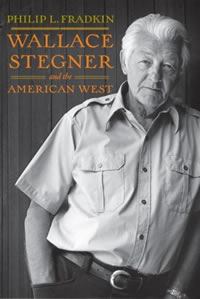Book Notes
 Philip L. Fradkin, Wallace Stegner and the American West (New York: Knopf, 2008), 369pp.
Philip L. Fradkin, Wallace Stegner and the American West (New York: Knopf, 2008), 369pp.
In his autobiographical novel Recapitulation (1979), Wallace Stegner (1909–1993) wrote of his character that "all his earliest years in Salt Lake had been an effort, much of the time as unconscious as growth itself and yet always there as if willed, to outgrow what he was and become what he was not. A stray, he yearned to belong. An outsider and an isolate, he aspired to friends and family and the community solidarity he saw all around him in that Mormon city" (41). In this comprehensive biography of Stegner, published to coincide with the centennial of his birth and written with the full cooperation of Stegner's only child, Page, Philip Fradkin shows just how true that was of his subject.
Stegner's earliest years began in an orphanage in Seattle, the drought-stricken frontier prairie of Saskatchewan homesteaders, a year in Great Falls, Montana (where at age eleven he encountered his first flush toilet and bath tub), and then twelve years in Salt Lake City and the University of Utah: "the happiest years I ever knew or will know." His father was a gambler and a bootlegger who moved the family twenty times in ten years to avoid raids, a man with a violent temper who died in a murder-suicide. Stegner hated his father and inherited that temper. He was plagued by guilt over his mother's hard life, and devoted to Mary, his wife of fifty-nine years.
Later years took Stegner to Harvard and then Stanford, where he founded the creative writing program and nurtured future writers like Wendell Berry and Larry McMurtry. Although he lived in the Stanford area for almost fifty years, he felt alienated from the university by the time he left, and a bitter argument led him to donate his papers to the University of Utah. A man who wrote eloquently about the power of place, he spent considerable time at a home in Vermont, which is where his ashes were spread after he died. Stegner won almost every literary award there is and his books have been translated into numerous languages, yet he was forever cast as a "regional" author and felt spurned by the east coast elites. His novel Angle of Repose won a Pulitzer in 1972 but was later mired in controversial and genuinely complex charges of plagiarism. Outwardly successful, Stegner was inwardly deeply insecure.
As Fradkin points out in his introduction, the previous two biographies of Stegner in 1997 and 1996 were written by professors of literature. He paints with a broader brush and hangs his narrative on the three major components of Stegner's life and work — Talented Teacher, Reluctant Conservationist, and Prominent Author. Fradkin honors Stegner but does not ignore the many contradictions in his life. Did he ever fit in or "become what he was not?" It's doubtful, Fradkin suggests; the autobiographical character Bruce Mason in Stegner's novel The Big Rock Candy Mountain asks, "But going home where. . . Where do I belong in this?" A bibliography of books by and about Stegner, along with a number of photos, complete the volume.


